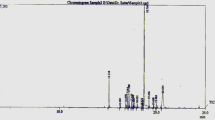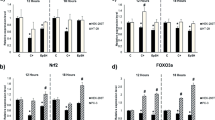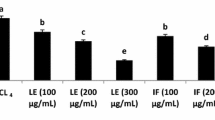Abstract
Oxidative stress in cells caused by excessive production of reactive oxygen species (ROS) and decreased antioxidant defense is implicated in the cytotoxicity of xenobiotics including drugs and environmental chemicals. Endosulfan, a highly toxic organochlorine insecticide, causes cytotoxic cell death by inducing oxidative stress. We have investigated the biochemical basis of induction of oxidative stress, involving the role of NADH dehydrogenase and the possible role of Na+, K+-ATPase in endosulfan cytotoxicity and, whether the cytotoxicity could be attenuated by targeting ROS induction using the natural flavonoid antioxidant, quercetin, in Ehrlich ascites tumor (EAT) cells. Exposure of cells to endosulfan caused cytotoxic cell death (necrosis) which was associated with induction of ROS, lipid peroxidation as well as a reduction in glutathione levels, concomitant with loss of NADH dehydrogenase and Na+, K+-ATPase activity in a dose-dependent manner, indicating that oxidative stress and perturbation of membrane function are the major causes of endosulfan cytotoxicity. Our results showed that quercetin, protected against endosulfan-induced cytotoxicity and significantly abrogated oxidative stress, and ameliorated the inhibition of NADH dehydrogenase and Na+, K+-ATPase activity in EAT cells. Our study presents evidence that NADH dehydrogenase inhibition plays an important role in oxidative stress-mediated cytotoxicity, and perturbed membrane function as evident from inhibition of sodium–potassium pump is involved in cytotoxic cell death.












Similar content being viewed by others
References
Dorval J, Hontela A (2003) Role of glutathione redox cycle and catalase in defense against oxidative stress induced by endosulfan in adrenocortical cells of rainbow trout (Oncorhynchus mykiss). Toxicol Appl Pharmacol 192:191–200. https://doi.org/10.1016/S0041-008X(03)00281-3
Rana I, Shivanandappa T (2010) Mechanism of potentiation of endosulfan cytotoxicity by thiram in Ehrlich ascites tumor cells. Toxicol In Vitro 24:40–44. https://doi.org/10.1016/j.tiv.2009.09.012
Srivastava A, Jagan Mohan Rao L, Shivanandappa T (2012) 2,4,8-Trihydroxybicyclo [3.2.1]octan-3-one scavenges free radicals and protects against xenobiotic-induced cytotoxicity. Free Radic Res 46:320–328. https://doi.org/10.3109/10715762.2012.655729
Kerr ME, Bender CM, Monti EJ (1996) An introduction to oxygen free radicals. Hear Lung 25:200–209
Syntichaki P, Tavernarakis N (2002) Death by necrosis. Uncontrollable catastrophe, or is there order behind the chaos? EMBO Rep 3:604–609. https://doi.org/10.1093/embo-reports/kvf138
Seis H (1991) Oxidative stress II: oxidants and antioxidants. Academic Press, London
Mitchell DB, Santone KS, Acosta D (1980) Evaluation of cytotoxicity in cultured cells by enzyme leakage. J Tissue Cult Methods 6:113–116. https://doi.org/10.1007/BF02082861
Dehn PF, Allen-Mocherie S, Karek J, Thenappan A (2005) Organochlorine insecticides: impacts on human HepG2 cytochrome P4501A, 2B activities and glutathione levels. Toxicol In Vitro 19:261–273. https://doi.org/10.1016/j.tiv.2004.10.002
Gupta PK, Gupta RC (1979) Pharmacology, toxicology and degradation of endosulfan. A review. Toxicology 13:115–130. https://doi.org/10.1016/S0300-483X(79)80016-5
Zervos IA, Nikolaidis E, Lavrentiadou SN et al (2011) Endosulfan-induced lipid peroxidation in rat brain and its effect on t-PA and PAI-1: ameliorating effect of vitamins C and E. J Toxicol Sci 36:423–433. https://doi.org/10.2131/jts.36.423
Jia Z, Misra HP (2007) Reactive oxygen species in in vitro pesticide-induced neuronal cell (SH-SY5Y) cytotoxicity: role of NFκB and caspase-3. Free Radic Biol Med 42:288–298. https://doi.org/10.1016/j.freeradbiomed.2006.10.047
Enhui Z, Na C, MengYun L, Jia Li, Dan Li, Yongsheng Y, Zhang Ying HD (2016) Isomers and their metabolites of endosulfan induced cytotoxicity and oxidative damage in SH-SY5Y cells. Environ Toxicol 31:496–504. https://doi.org/10.1002/tox
Sohn HY, Kwon CS, Kwon GS et al (2004) Induction of oxidative stress by endosulfan and protective effect of lipid-soluble antioxidants against endosulfan-induced oxidative damage. Toxicol Lett 151:357–365. https://doi.org/10.1016/j.toxlet.2004.03.004
Turrens JF, Boveris A (1980) Generation of superoxide anion by the NADH dehydrogenase of bovine heart mitochondria. Biochem J 191:421–427. https://doi.org/10.1042/bj1910421
Kohlhaas M, Liu T, Knopp A et al (2010) Elevated cytosolic Na+ increases mitochondrial formation of reactive oxygen species in failing cardiac myocytes. Circulation 121:1606–1613. https://doi.org/10.1161/CIRCULATIONAHA.109.914911
Kaplan JH (2002) Biochemistry of Na, K-ATPase. Annu Rev Biochem 71:511–535. https://doi.org/10.1146/annurev.biochem.71.102201.141218
Lemasters JJ, Qian T, He L, Kim JS, Elmore SP, DA Cascio WEB (2002) Role of mitochondrial inner membrane permeabilization in necrotic cell death, apoptosis, and autophagy. Antioxid Redox Signal 4:769–781. https://doi.org/10.1089/152308602760598918
Rodrigo R, Trujillo S, Bosco C, Orellana M, Thielemann LAJ (2002) Changes in Na+, K+-adenosine triphosphate activity and ultrastructure of lung and kidney associated with oxidative stress induced by acute ethanol intoxication. Chest 121:589–596
Feissner RF, Skalska J, Gaum WE, Sheu SS (2009) Crosstalk signaling between mitochondrial Ca2+ and ROS. Front Biosci 14:1197–1218. https://doi.org/10.2741/3303
Denton RM (2009) Regulation of mitochondrial dehydrogenases by calcium ions. Biochim Biophys Acta 1787:1309–1316. https://doi.org/10.1016/j.bbabio.2009.01.005
Srivastava A, Shivanandappa T (2006) Causal relationship between hexachlorocyclohexane cytotoxicity, oxidative stress and Na+, K+-ATPase in Ehrlich ascites tumor cells. Mol Cell Biochem 286:87–93. https://doi.org/10.1007/s11010-005-9096-0
Srivastava A, Shivanandappa T (2009) Stereospecificity in the cytotoxic action of hexachlorocyclohexane isomers. Chem Biol Interact 183:34–39. https://doi.org/10.1016/j.cbi.2009.09.026
Estrela JM, Hernandez R, Terradez P et al (1992) Regulation of glutathione metabolism in Ehrlich ascites tumour cells. Biochem J 286:257–262
Frandsen A, Schousboe A (1987) Time and concentration dependency of the toxicity of excitatory amino acids on cerebral neurones in primary culture. Neurochem Int 10:583–591. https://doi.org/10.1016/0197-0186(87)90088-X
Bergmeyer HU (1974) Methods of enzymatic analysis. Academic Press, New York
Aust S (1994) Thiobarbituric acid assay reactants. In: Tyson CA, Frazier JM (eds) Methods in toxicology 1B. Academic Press, San Diego, pp 367–374
Cereser C, Boget S, Parvaz P, Revol A (2001) Thiram-induced cytotoxicity is accompanied by a rapid and drastic oxidation of reduced glutathione with consecutive lipid peroxidation and cell death. Toxicology 163:153–162. https://doi.org/10.1016/S0300-483X(01)00401-2
Pompéia C, Cury-Boaventura MF, Curi R (2003) Arachidonic acid triggers an oxidative burst in leukocytes. Braz J Med Biol Res 36:1549–1560
Ellman GL (1959) Tissue sulfhydryl groups. Arch Biochem Biophys 82:70–77
Bloj B, Morero RD, Farias RNTR (1973) Membrane lipid fatty acids and regulation of membrane-bound enzymes. Allosteric behaviour of erythrocyte Mg2+-ATPase, (Na+K+)-ATPase and acetylcholineasterase from rats fed different fat-supplemented diets. Biochim Biophys Acta 311:67–79
Chen PS, Toribara TY, Warner H (1956) Microdetermination of phosphorus. Anal Chem 28:1756–1758. https://doi.org/10.1021/ac60119a033
Baehner RL, Nathan D (1968) Quantitative nitroblue tetrazolium test in chronic granulomatous disease. N Engl J Med 278:971–976
Gella FJ, Olivella MT, Pegueroles F, Gener J (1981) Colorimetry of diaphorase in commercial preparations and clinical chemical reagents by use of tetrazolium salts. Clin Chem 27:1686–1689
Lowry OH, Rosenburg NJ, Farr ALRR (1951) Protein measurement with the folin phenol reagent. J Biol Chem 193:265–275. https://doi.org/10.1016/0304-3894(92)87011-4
Halliwell B (1999) Oxygen and nitrogen are pro-carcinogens. Damage to DNA by reactive oxygen, chlorine and nitrogen species: measurement, mechanism and the effects of nutrition. Mutat Res 443:37–52. https://doi.org/10.1016/S1383-5742(99)00009-5
Dorval J, Leblond VS, Hontela A (2003) Oxidative stress and loss of cortisol secretion in adrenocortical cells of rainbow trout (Oncorhynchus mykiss) exposed in vitro to endosulfan, an organochlorine pesticide. Aquat Toxicol 63:229–241. https://doi.org/10.1016/S0166-445X(02)00182-0
Pandey S, Ahmad I, Parvez S et al (2001) Effect of endosulfan on antioxidants of freshwater fish Channa punctatus bloch: 1. Protection against lipid peroxidation in liver by copper preexposure. Arch Environ Contam Toxicol 41:345–352. https://doi.org/10.1007/s002440010258
Hincal F, Gürbay A, Giray B (1995) Induction of lipid peroxidation and alteration of glutathione redox status by endosulfan. Biol Trace Elem Res 47:321–326. https://doi.org/10.1007/BF02790133
Rauchov H, Ledvinkova J, Kalous M, Drahota Z (1995) The effect of lipid peroxidatiun on the activity of various membrane-bound ATPases in rat kidney. Int J Cell Biol 27:251–255
Chen D, Song M, Mohamad O, Yu SP (2014) Inhibition of Na+/K+-ATPase induces hybrid cell death and enhanced sensitivity to chemotherapy in human glioblastoma cells. BMC Cancer 14:716. https://doi.org/10.1186/1471-2407-14-716
Yu SP (2003) Na+, K+-ATPase: the new face of an old player in pathogenesis and apoptotic/hybrid cell death. Biochem Pharmacol 66:1601–1609. https://doi.org/10.1016/S0006-2952(03)00531-8
Choi DW (1988) Calcium-mediated neurotoxicity: relationship to specific channel types and role in ischemic damage. Trends Neurosci 11:465–469. https://doi.org/10.1016/0166-2236(88)90200-7
Lambeth JD (1988) Activation of the respiratory burst oxidase in neutrophils: on the role of membrane-derived second messengers, Ca++, and protein kinase C. J Bioenerg Biomembr 20:709–733. https://doi.org/10.1007/BF00762549
Tian J, Liu J, Garlid KD et al (2003) Involvement of mitogen-activated protein kinases and reactive oxygen species in the inotropic action of ouabain on cardiac myocytes. A potential role for mitochondrial KATP channels. Mol Cell Biochem 242:181–187. https://doi.org/10.1023/A:1021114501561
Xie Z, Kometiani P, Liu J et al (1999) Intracellular reactive oxygen species mediate the linkage of Na+/K+-ATPase to hypertrophy and its marker genes in cardiac myocytes. J Biol Chem 274:19323–19328. https://doi.org/10.1074/JBC.274.27.19323
Liu J, Tian J, Haas M et al (2000) Ouabain interaction with cardiac Na+/K+-ATPase initiates signal cascades independent of changes in intracellular Na+ and Ca2+ concentrations. J Biol Chem 275:27838–27844. https://doi.org/10.1074/jbc.M002950200
Srivastava SC, Kumar R, Prasad AK, Srivastava SP (1995) Effect of hexachlorocyclohexane (HCH) on testicular plasma membrane of rat. Toxicol Lett 75:153–157. https://doi.org/10.1016/0378-4274(94)03173-5
Naqvi SM, Vaishnavi C (1993) Bioaccumulative potential and toxicity of endosulfan insecticide to non-target animals. Comp Biochem Physiol C 105:347–361. https://doi.org/10.1016/0742-8413(93)90071-R
Aggarwal M, Naraharisetti SB, Sarkar SN et al (2009) Effects of subchronic coexposure to arsenic and endosulfan on the erythrocytes of broiler chickens: a biochemical study. Arch Environ Contam Toxicol 56:139–148. https://doi.org/10.1007/s00244-008-9171-0
Zorov DB, Juhaszova M, Sollott SJ (2014) Mitochondrial reactive oxygen species (ROS) and ROS-induced ROS release. Physiol Rev 94:909–950. https://doi.org/10.1152/physrev.00026.2013
Davies KJA, Doroshow JH, Hochstein P (1983) Mitochondrial NADH dehydrogenase-catalyzed oxygen radical production by adriamycin, and the relative inactivity of 5-iminodaunorubicin. FEBS Lett 153:227–230. https://doi.org/10.1016/0014-5793(83)80153-7
Doroshow JH (1983) Anthracycline antibiotic-stimulated superoxide, hydrogen peroxide, and hydroxyl radical production by NADH dehydrogenase anthracycline antibiotic-stimulated superoxide, hydrogen peroxide, and hydroxyl radical production by NADH dehydrogenase1. Cancer Res 43:4543–4551
Sherer TB, Richardson JR, Testa CM et al (2007) Mechanism of toxicity of pesticides acting at complex I: relevance to environmental etiologies of Parkinson’s disease. J Neurochem 100:1469–1479. https://doi.org/10.1111/j.1471-4159.2006.04333.x
Pandya JD, Nukala VN, Sullivan PG (2013) Concentration dependent effect of calcium on brain mitochondrial bioenergetics and oxidative stress parameters. Front Neuroenergetics 5:1–12. https://doi.org/10.3389/fnene.2013.00010
Malyala S, Zhang Y, Strubbe JO, Bazil JN (2019) Calcium phosphate precipitation inhibits mitochondrial energy metabolism. PLoS Comput Biol 15:1–19. https://doi.org/10.1371/journal.pcbi.1006719
Chen YR, Chen CL, Zhang L et al (2005) Superoxide generation from mitochondrial NADH dehydrogenase induces self-inactivation with specific protein radical formation. J Biol Chem 280:37339–37348. https://doi.org/10.1074/jbc.M503936200
Mårtensson J, Jain A, Stole E et al (1991) Inhibition of glutathione synthesis in the newborn rat: a model for endogenously produced oxidative stress. Proc Natl Acad Sci USA 88:9360–9364. https://doi.org/10.1073/pnas.88.20.9360
Bayoumi AE, García-Fernández AJ, Ordóñez C et al (2001) Cyclodiene organochlorine insecticide-induced alterations in the sulfur-redox cycle in CHO-K1 cells. Comp Biochem Physiol C 130:315–323. https://doi.org/10.1016/S1532-0456(01)00257-5
Boots AW, Haenen GRMM, Bast A (2008) Health effects of quercetin: From antioxidant to nutraceutical. Eur J Pharmacol 585:325–337. https://doi.org/10.1016/j.ejphar.2008.03.008
Karuppagounder SS, Madathil SK, Pandey M et al (2013) Quercetin up-regulates mitochondrial complex-I activity to protect against programmed cell death in rotenone model of Parkinson’s disease in rats. Neuroscience 236:136–148. https://doi.org/10.1016/j.neuroscience.2013.01.032
Spector M, Neal SO, Racker E (1980) Reconstitution of the Na+, K+ pump of ehrlich ascites tumor and enhancement of efficiency by quercetin. J Biol Chem 255(12):5504–5507. https://doi.org/10.1080/00021369.1977.10862635
Punithavathi VR, Prince PSM (2010) Pretreatment with a combination of quercetin and a-tocopherol ameliorates adenosine triphosphatases and lysosomal enzymes in myocardial infarcted rats. Life Sci 86:178–184. https://doi.org/10.1016/j.lfs.2009.11.021
Acknowledgements
This work was carried out as a part of the M.Sc. dissertation of the first two authors at Central Food Technological Research Institute, Mysore, India, during the senior author’s tenure. The authors thank Dr. Anup Srivastava, Dr. Y. Rajashekar and K.R. Ritesh for their technical and timely help. The authors also thank the Director of the institute for supporting this study.
Author information
Authors and Affiliations
Corresponding author
Ethics declarations
Conflict of interest
The authors declare that they have no conflict of interest.
Additional information
Publisher's Note
Springer Nature remains neutral with regard to jurisdictional claims in published maps and institutional affiliations.
Rights and permissions
About this article
Cite this article
Murali, M., Carvalho, M.S. & Shivanandappa, T. Oxidative stress-mediated cytotoxicity of Endosulfan is causally linked to the inhibition of NADH dehydrogenase and Na+, K+-ATPase in Ehrlich ascites tumor cells. Mol Cell Biochem 468, 59–68 (2020). https://doi.org/10.1007/s11010-020-03711-z
Received:
Accepted:
Published:
Issue Date:
DOI: https://doi.org/10.1007/s11010-020-03711-z




